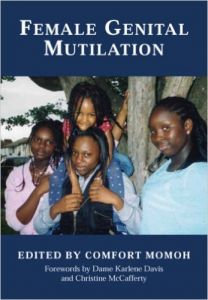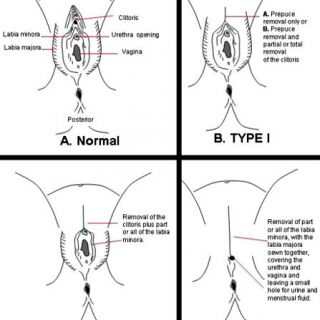Female genital mutilation


Female Genital Mutilation” was published by Radcliffe Medical Press (2005)
Female Genital Mutilation (FGM) is recognised worldwide as a fundamental violation of the human rights of girls and women. It reflects deep-rooted inequality between the sexes and constitutes an extreme form of discrimination against women.
FGM involves violation of rights of the children and violation of a person’s right to health, security, and physical integrity, the right to be free from torture and cruel, inhuman, or degrading treatment, and the right to life when the procedure results in death.
Furthermore, girls usually undergo the practice without their informed consent, depriving them of the opportunity to make independent decision about their bodies (Okeke 2012).
World Health Classification of FGM
There are four main types of FGM. These are:
• Type 1, also known as “clitoridectomy,” is the excision of the clitoral prepuce (or “hood”) and may also involve excision of all or part of the clitoris;
• Type 2 is the excision of the clitoris and may also involve excision of all or part of the labia minora (the smaller, inner vaginal lips);
• Type 3, also known as “infibulation,” involves excision of part or all of the external genitalia and the stitching or narrowing of the vaginal opening, and
• Type 4 refers to all other genital procedures (WHO 2014).

FGM has no medical or health benefit and the procedures are irreversible and their effects last a lifetime, although the health impacts of FGM may be reduced in some cases.
Reasons behind FGM
Communities that practise FGM put forward many reasons and beliefs for the practice. Some of the most common beliefs about FGM are that it promotes chastity, prevents promiscuity, promotes cleanliness and helps to secure a good marriage for one’s daughter. Some people also believe that FGM is a religious obligation. This is not true, FGM is not in the Bible or in the Koran; it has nothing to do with religion.
Most communities that practise FGM believe they are doing the best for their daughters and they sometimes do not see FGM as a form of abuse. This can be challenging to professionals and it is our legal duty to provide information to these communities and help to safeguard girls that might be at risk of FGM.
Who performs FGM?
FGM is commonly performed by traditional birth attendants, local women or men, or female family members. Such individuals do not have formal medical training and usually perform FGM without anaesthesia or sterilisation. It is not uncommon for those who perform FGM to cut or damage more of the genital area than they intend. For example, an unskilled person may intend to perform Type 1 FGM, but do more damage to adjacent organs resulting in Type 3 FGM.
Dangers
FGM can be potentially very dangerous for women’s health and psychological well-being. It can lead to severe health problems, and in some cases, to death. FGM causes gynaecological, urological, and obstetric problems in women. Indeed, FGM doubles the risk of the mother’s death in childbirth and increases the risk of the child being born dead by three to four times. During and immediately after the FGM procedure, women can experience significant pain and may suffer haemorrhage, shock, infection, urine retention, and injury to adjacent tissue, and ulceration of the genital region. In extreme cases, women may die from severe haemorrhaging.
Key facts
• FGM includes procedures that intentionally alter or cause injury to the female genital organs for non-medical reasons.
• The procedure has no health benefits for girls and women.
• Procedures can cause severe bleeding and problems urinating, and later cysts, infections, as well as complications in childbirth and increased risk of newborn deaths.
• More than 200 million girls and women alive today have been cut in 30 countries in Africa, the Middle East and Asia where FGM is concentrated1.
• FGM is mostly carried out on young girls between infancy and age 15.
• FGM is a violation of the human rights of girls and women (UN 2016).
Role of professionals
Professionals have a pivotal role to play in identifying, sharing information and reporting cases of FGM.
Professionals must assess risk of FGM and treat it as a child abuse-safeguarding and make referrals of under 18 years of age to the police-101. This is a legal requirement and responsibility.
Risk assessment
Indicators that FGM may already have occurred included absence from school or other activities with noticeable behaviour change on return. Physical indications include recurrent urinary tract infection, pain or frequenting toilet.
If concern or worried that a girl might be at risk of FGM, please call your local helpline.
Intercollegiate recommendations (2013)
1. Treat FGM as a child abuse;
2. Document and collect information;
3. Share that information systematically;
4. Empower frontline professionals;
5. Identify girls at risk and refer them as part of child safeguarding obligation;;
6. Report cases of FGM;
7. Hold frontline professionals accountable;
8. Empower and support affected girls ang young women (both those at risk and survivors; and
9. Implement awareness campaign.
FGM and the law
FGM is a crime in the UK and has been a specific criminal offence since the Prohibition of Female Circumcision Act 1985 came into force on 16 September 1985. The 1985 Act was replaced by the Female Genital Mutilation Act 2003. It’s also illegal to take abroad a British national or permanent resident for FGM, or to help someone trying to do this. There is up to 14 years in prison for carrying out FGM or helping it to take place. The FGM protection orders and the Serious Crime Act 2015 allows judges to remand people in custody, order mandatory medical checks and instruct girls believed to be at risk of the practice to live at a particular address so that authorities can check whether they have been subjected to it. Victims are also given lifelong anonymity.
Key facts
• FGM includes procedures that intentionally alter or cause injury to the female genital organs for non-medical reasons.
• The procedure has no health benefits for girls and women.
• Procedures can cause severe bleeding and problems urinating, and later cysts, infections, as well as complications in childbirth and increased risk of newborn deaths.
• More than 200 million girls and women alive today have been cut in 30 countries in Africa, the Middle East and Asia where FGM is concentrated.
• FGM is mostly carried out on young girls between infancy and age 15.
• FGM is a violation of the human rights of girls and women.
Convention and Charter
• Convention against Torture and other cruel, Inhuman or Degrading Treatment or Punishment.
• The African Charter on the Rights and Welfare of the Child, 1981
• African Charter on Human and Peoples’ Right (the Banjul Charter) and it’s Protocol on the Rights of Women in Africa.
• The convention on Elimination of All forms of discrimination Against women 1979 – The Vienna Declaration and Programme of Action 1993
• The Beijing Declaration on Women’s Right 1995 and the United Nation Convention on the Right of the Child 1989.
Author: Dr. Comfort Momoh, MBE, FGM/Public Health Specialist,Guy’s and St Thomas Foundation Trust, London (UK), Comfort.Momoh@gstt.nhs.uk

